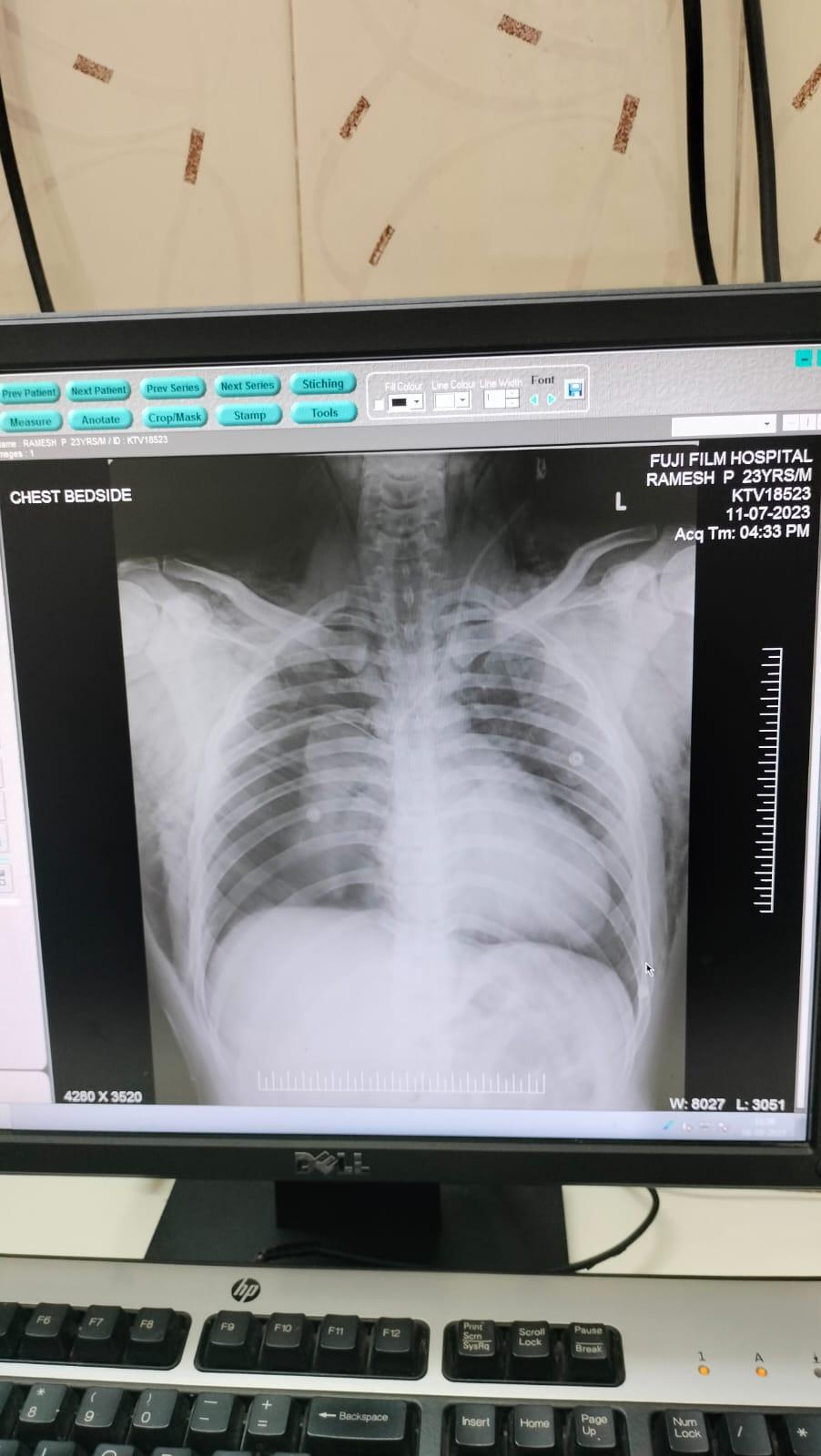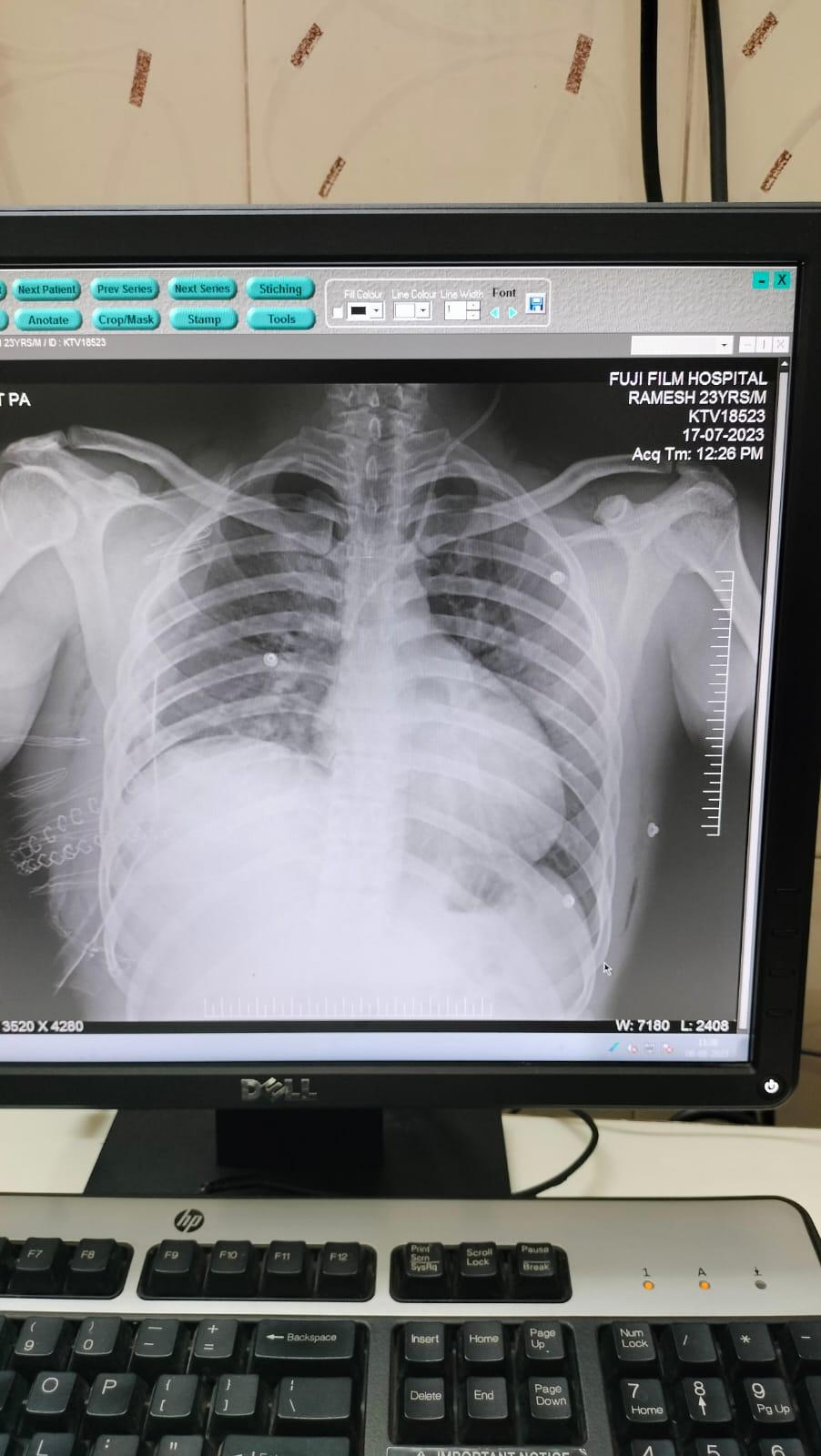Stab Injury: A Case Report
- Marilakshmi Nurse Educator, Kauvery Hospital, Tirunelveli
Background
A stab wound is a specific form of penetrating trauma to the skin that results from a knife or a similar pointed object. While stab wounds are typically known to be caused by knives, they can also occur from various implements, including broken bottles and ice picks.
Case Presentation
Patient X came with a history of assault by a known person. The person stabbed the patient chest by using a knife. He has difficulty in breathing. After the examination, the doctor confirmed bilateral chest subcutaneous emphysema and planned to do an exploratory thoracotomy.
Examination
CVS: S1,S2 present., RS: Bilateral air entry is present, P/A: soft.
SAO2: 90%, BP: 120/90mmhg, HR: 82 beats/mts,RR: 26 breath/mts
Bilateral subcutaneous emphysema in chest present.
Laceration present 4X1 cm at right upper chest.
Provisional diagnosis
- Bilateral subcutaneous emphysema
- Laceration at right upper chest
- Pneumothorax
Investigation
- Ultrasound Scan of Abdomen
- Minimal Bilateral Pleural Effusion.
- Normal study of solid intra-abdominal organs
- C.T Scan Thorax
- Surgical Emphysema.
- Pneumomediastinum and pneumopericardium.
- Minimal left pneumothorax, passive collapse left lung with contusion posterior basal segment and pneumatocyst
- Massive right pneumothorax with ICD in situ, passive collapse of right lung (Fallen lung) due to P/o Broncho Pleural fistula.
- C.T SCAN OF BRAIN (PLAIN)
- No anatomical lesion made out in brain
- Pneumo orbit and surgical emphysema faciomaxillary region.
- C.T SCAN OF FACIAL BONE (PLAIN)
- No anatomical lesion made out in facial bones.
- Surgical emphysema periorbital, faciomaxillary and neck region.
- X-RAY CHEST AP VIEW
- Surgical Emphysema.
- Contusion left mid zone.
- Resolving pneumothorax with ICD insitu on right.
Before Procedure

After Procedure

Surgery Exploratory Thoracotomy
Patient under general anaesthesia. The chest was opened through the right posterolateral thoracic wall. The right lung collapsed with clots in the right thoracic cavity. There is a tear in the right main bronchus with continuous air blocks. The bronchus and right lung hilum were sutured by using absorbable suture materials. After that lung well expanded. chest was closed. ICD was done.
Treatment
- Inj.Piptaz-4.5mg-Iv-Tds
- Inj.Amikacin-500mg-Iv-Tds
- Inj.Flagyl-500mg-Iv-Bd
- Inj.Pantocid-40mg-Iv-bd
- Inj.Paraglass-1 gm -Iv-Tds
- Inj.Tramadol-Iv-Tds
- Inj.Emeset-8mg-Iv-Bd
- Neb.Duolin, Budecort, Glycopyrronium
- Syr.Mucolite-10ml
Diet advice
High protein diet
Nursing management
Chest tube drainage and suction are used to re-expand the lungs and to remove remaining air or fluid. Auscultate breath sounds. The findings on lung auscultation also vary depending on the extent of the pneumothorax. Unilaterally decreased or absent lung sounds are common findings but decreased air entry may be absent even in an advanced disease state.
The focus of pain management for patients with hemothorax and pneumothorax is to provide comfort and facilitate adequate respiratory function. The primary goal is to provide effective pain relief through the use of appropriate analgesic medications, considering the severity of pain and the individual patient’s needs. Close monitoring of pain levels and adjusting the pain management plan accordingly is crucial to ensure optimal pain control and patient comfort.
- Reexpansion:The patient is instructed to inhale and strain against a closed glottis to reexpand the lung and eject the air from the thorax.
- Sterile covering: The opening is plugged by sealing it with gauze impregnated withpetrolatum
- Oxygen saturation: Pulse oximetry is used to monitor oxygen level.
Providing Patient Education & Health Teachings. When providing patient education and health teachings for patients with hemothorax and pneumothorax, it is important to educate the patients about the condition, its causes, symptoms, and potential complications. Patients should be informed about the importance of seeking immediate medical attention if symptoms occur.
Outcome
On discharge, patient was hemodynamically stable.

Ms. K. Marilakshmi
Nurse Educator
